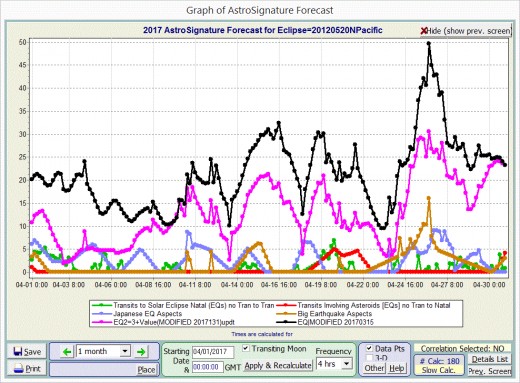Seismic Review and Forecast for April, 2017
Before and After (Seismic Storm and Then Drought)


Curiouser and Curiouser Sayeth the Soothsayer
In my last article, I mentioned how the world was going through an active period of earthquakes in the 7.8 magnitude or higher range, beginning in November 2016 and ending in January 2017. When that period ended, it was pretty final as well. Looking at the past two months of February and March of 2017, activity for quakes in the 5.8 magnitude or larger range has been less than half of normal (33-40% of the average monthly rate based on data from the USGS from 1992-2015).
Also from my last piece, indications were that things would pick up later in the month of March when there would be a spike in Astro-Aspect Values (AAVs) or angular relationships between solar system bodies that have shown a correlation with past large earthquakes of significant size (at least 6.75 in magnitude). There was also a heliocentric (sun centered view of our solar system) relationship of Mars to our Sun late in the month of February 2017. The event was Mars crossing the ecliptic plane as it moved from below it to above it (conjunct its ascending or north node) on 27 February 2017. In the past, very large earthquakes often occur around such times. In the case of the current period, from 13 February through 1 March 2017, for quakes from around 6.5 to 7.7 magnitude, and for larger quakes, extending as much as a month before to two months after (there was already a 7.8M quake on 22 January 2017 in the Papua New Guinea area).


There was a 6.8 or 6.9 magnitude event on 24 February 2017, south of the Fiji Islands which fit into the Mars related window and a 6.6 or 6.7 magnitude event on 29 March 2017, on the east coast of the Kamchatka peninsula of Russia, which was within a window of five days (27 March through 31 March 2017), surrounding a large peak in AAVs. It was expected by this forecaster that there would be at least two sizable seismic events in March but, since earthquakes are only coming in at less than half the usual rate, that was not to be.
More News on the Face of the Sun Than on the Home Planet
Interestingly, the Sun showed a significant peak in sunspot activity a day before Mars contacted its north node. There was another peak corresponding to another heliocentric event at the end of March. That exact aspect of what is called a T-square in astrology, involved the planet Mercury opposite the minor planet of Pluto (180 degrees from) and the planet Jupiter squaring the two (90 degrees from each).

However, as iffy as February and March looked, April and May show little signs that things, as far as astrology is concerned, will be anything other than above par. In other words, what we have just been experiencing is a pause or calm before a continuation of the storm that was witnessed earlier from 13 November 2016 to 22 January 2017. At the same time, I expect things to get ratcheted up a bit from the 7.8 to 7.9 magnitude level, seen during the last storm, to at least one quake that will exceed that range. Incidentally, one esteemed source of seismological information, namely INGV or Centro Nazionale Terremoti (National Earthquake Center based in Rome, Italy), gives two quakes from that earlier storm as being 8.1 in magnitude (the New Zealand quake of 13 November 2016 and the Papua New Guinea quake of 17 December 2016).

And Now for the Forecast...
Looking at April 2017, significant seismic events could start as early as the 1st of the month, but most likely things will wait as the chances increase as the month progresses. This is demonstrated below in the table showing the beginning and end of the windows, the number of days that they will last and the percentage above average for a significant event of at least 6.7 magnitude to occur within them.

Since the only earthquakes of significance during the past two months were located near the Fiji Islands and Kamchatka, those areas are potential spots on the globe for future larger earthquakes. However, there is almost no area except perhaps the continental United States that are exempt of potential for a very large earthquake (7.0 magnitude or greater) during April 2017. The continental U.S. has a much greater chance of such a quake after the total solar eclipse in August of 2017. Japan, followed by Alaska and Chile are likely areas of a very big seismic event, especially towards the end of April 2017. Outlooks for May 2017 will be shared in an article due out at the start of that month.
This article is accurate and true to the best of the author’s knowledge. Content is for informational or entertainment purposes only and does not substitute for personal counsel or professional advice in business, financial, legal, or technical matters.
© 2017 Joseph Ritrovato








